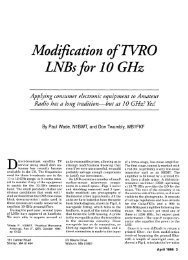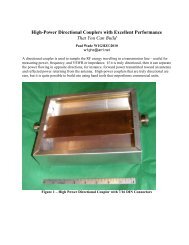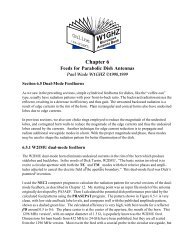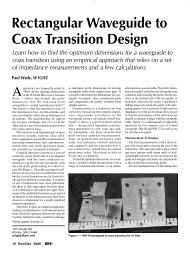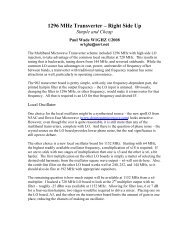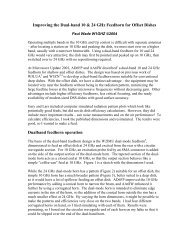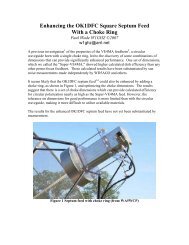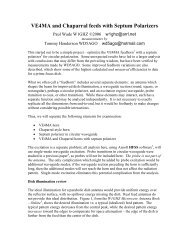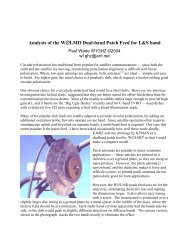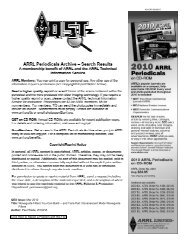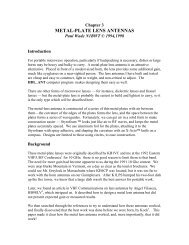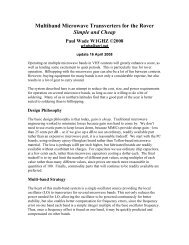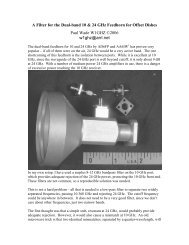Small Dishes - W1GHZ
Small Dishes - W1GHZ
Small Dishes - W1GHZ
You also want an ePaper? Increase the reach of your titles
YUMPU automatically turns print PDFs into web optimized ePapers that Google loves.
SummaryThe test results in Appendix A are very encouraging. The measurements by WD5AGOare completely independent from the simulations by <strong>W1GHZ</strong>, yet the comparable resultsare consistent. The efficiency derived from sun noise measurements is 12 to 14% lowerthan efficiency calculated from simulations in all cases. Previous tests have shown realworld efficiency to be about 15% lower than simulation for small dishes. Therefore, wemay believe that the measurements validate the simulation results.Our results have surpassed the original objective. In addition finding excellentcombinations of the VE4MA and Chaparral feedhorns with septum polarizers, we havediscovered some improved dimensions for these feedhorns which offer improvedperformance. Measured efficiencies as high as 65% surpass any previous amateur resultsfor a prime-focus dish, as well as most commercial results. Thus, we may draw someconclusions:• The original VE4MA feedhorn provides good efficiency for a wide range of dish f/D.• The Chaparral feedhorn provides somewhat better efficiency for a wide range of dishf/D, and the highest to date for very deep dishes, with f/D ~ 0.25.• A larger version of the VE4MA feed, which we call the “Super VE4MA,” providesexcellent efficiency, the highest to date for a prime-focus dish, but over a smallerrange of dish f/D.• <strong>Small</strong>er versions of the VE4MA feed work as well as the original over a broad rangeof ring dimensions, offering lower blockage for very small dishes.• The probe is not part of the antenna. It could be 100 meters away, at the far end of thefeedline. The loss might reduce the transmitted power, but will not affect the radiationpattern of the antenna.• The polarizer is not part of the antenna – just like the probe.• The septum polarizer, or any other polarizer, does not affect the antenna radiation,except to make the polarization circular; any polarizer that excites the antenna withgood CP will result in the same pattern. Of course, a poor polarizer will degradeperformance.• All these feedhorns work well (in simulation) with the OK1DFC septum polarizer toprovide circular polarization, but the VE4MA feed and variations degrade slightly forf/D < 0.35.• For linear polarization, horn diameters of 0.71λ and 0.77λ work equally well, andthere is no reason to believe that intermediate diameters will not work as well. TheOK1DFC septum polarizer works best with a waveguide diameter of 0.71λ.• The range of feed dimensions that yields very good performance providesopportunities to use available materials effectively.If you have a feed that is working well and providing good results, there is no need tochange it. However, if you feel that a better feed could help, or if you don’t have a feedyet and are still deciding, then one of the improved feeds described here could be a goodchoice. But the most important part is to put a feed in your dish and get it on the air!
References1. B.W. Malowanchuk, VE4MA, "VE4MA 3456 MHz circular polarization feed horn,"North Texas Microwave Society Feedpoint, Nov/Dec 1991.2. Zdenek Samek, OK1DFC, “Feed for Parabolic Dish with Circular Polarization,”CD-ROM for 10 th International EME Conference 2002 in Prague. www.ok1dfc.com3. www.ansoft.com4. P. Wade, <strong>W1GHZ</strong>, “Understanding Circular Waveguide – Experimentally,” QEX,Jan/Feb 2001, pp. 37-48. www.w1ghz.org/QEX/circular_wg.pdf5. P. Wade, <strong>W1GHZ</strong>, The <strong>W1GHZ</strong> Microwave Antenna Book – Online, www.w1ghz.org6. A. Kumar, "Reduce Cross-Polarization in Reflector-Type Antennas," Microwaves,March 1978, pp. 48-51.7. R. Wohlleben, H. Mattes, O. Lochner, "Simple small primary feed for large openingangles and high aperture efficiency," Electronics Letters, 21 Sept. 1972, pp. 181-183.(reprinted in A.W. Love, Electromagnetic Horn Antennas, IEEE, 1976, pp. 181-183.)8. M. Chen & G. Tsandoulas, “A wide-band square-waveguide array polarizer,” IEEETransactions on Antennas and Propagation, May 1973, pp. 389-391.9. P. Wade, <strong>W1GHZ</strong>, “Analysis of the OK1DFC Septum Feed,” DUBUS, 1/2003, pp.22-38.10. J. Bornemann & V.A. Labay, “Ridge Waveguide Polarizer with Finite and Stepped-Thickness Septum,” IEEE Transactions on Microwave Theory and Techniques,August 1995, pp. 1782-1787.11. J.S. Hollis, T.J. Lyon, & L. Clayton, Jr., “Microwave Antenna Measurements,”Scientific-Atlanta, July, 1970, p. 10-13.



